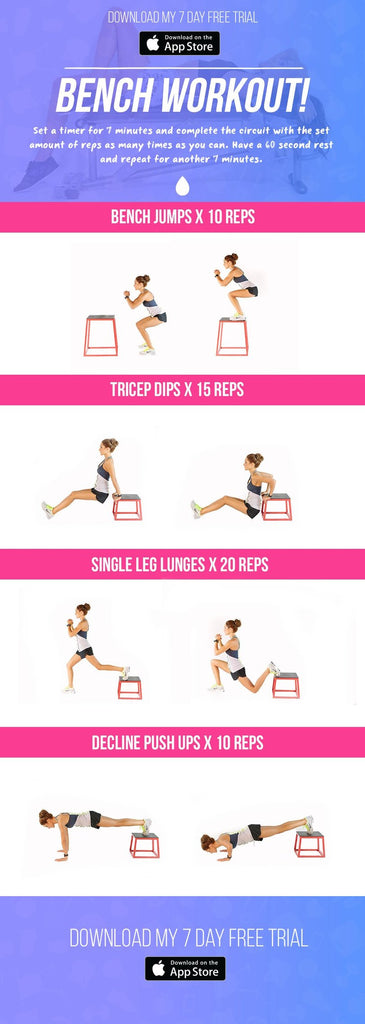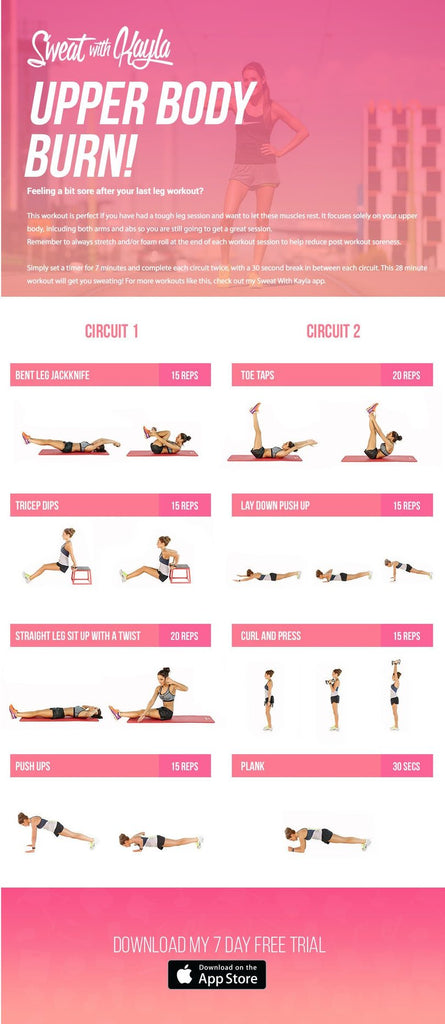Warm Up Exercises For Cardio & Weights


So many people underestimate the importance of a proper warm up before their workout. Warming up with cardio exercises and dynamic stretching can help you to have a successful workout!
Doing a warm up may seem like a hassle or something that you don’t have time for when you are in a hurry, but it is actually SO important. I highly recommended taking five minutes to warm up even if it means making your workout shorter. Here’s why.
Find out:
Why you need to warm up
A gradual warm up is important because it tells your body that it’s about to do some work, so get ready! Using dynamic exercises to activate the central nervous system and get your blood flowing, you prime the muscles and tendons you’re about to use during your workout. This is especially important if you’ve just woken up or you’ve been sitting all day.
When you do any form of exercise, your muscles shorten and lengthen. If you haven’t warmed up properly and you jump straight into your workout, you’re at risk of pulling or tearing a muscle.
Your cardiovascular system also has to adjust to exercise — your heart rate increases, you breathe harder; more blood flows to your muscles, and nervous system activity also increases.
These changes don’t happen instantly, so it is important to warm up your body for a few minutes in order for these changes to occur.
Dynamic exercises that move your joints through their range of motion ensure that you have maximum flexibility for the workout. This makes it easier to complete the exercises with proper form, and you’re more resilient to injury, too.
Warming up before your workout may even help you to avoid delayed onset muscle soreness after your workout. A thorough warm up is very important before a high-intensity workout to ensure you get the most out of your training.
What to do in your warm up
A warm up usually consists of some form of cardiovascular (cardio) exercise, foam rolling and some dynamic movement such as arm or leg swings. It doesn’t have to take a long time, but you DO need to do it!
You can get the blood flowing with a few minutes of walking, jogging on the spot or jumping rope. Then focus on the muscle groups and joints you’ll be using for your workout.
My top warm up exercises for cardio
Do these exercises before your next cardio session! I recommend taking about one minute for each exercise and make sure you do both sides of your body!
Foam rolling (glutes)
Position the foam roller horizontally behind you. Carefully sit on top of the foam roller and place both hands on the floor behind you.
Lift and turn out your right leg so that your ankle is resting on your left leg just above your knee, as shown. Gently tilt your hips to the right to allow the foam roller to press into your right gluteal.
Slowly roll the foam roller along the length of your gluteal. Once you reach a point of tenderness (called a trigger point), pause and hold that position for around 60 seconds or until the pressure/pain is significantly reduced. You can choose to perform small strokes over the point of tenderness if you would prefer.
Continue to roll down the length of your gluteal, pausing on trigger points as needed.
Four-point thoracic rotation
Start on all fours ensuring that your knees are below your hips and your hands are below your shoulders. While maintaining a neutral spine and stabilising through your abdominals, draw your shoulder blades down and back. This is your starting position.
While keeping your lower body as still as possible, rotate your torso to bring your right elbow towards your left elbow.
Slowly rotate your torso to open your chest and point your elbow towards the ceiling, or as far as you can while maintaining a neutral spine and keeping your lower body as still as possible. Hold this position for approximately three to five seconds, breathing deeply throughout.
Rotate your torso towards your left elbow to return to the starting position. Hold this position for approximately three to five seconds, breathing deeply throughout.
Complete six repetitions on each side.
Four-point arm & leg extension
Starting on all fours on a yoga mat, ensure that your knees are below your hips and your hands are below your shoulders. Set your spine in a neutral position and draw your shoulder blades down and back. This is your starting position.
Release and elevate your right arm and left leg until they are in line with your spine, ensuring that your shoulders and hips remain parallel to (in line with) the floor.
Lower your right arm and left leg to return to the starting position.
Release and elevate your left arm and right leg until they are in line with your spine, ensuring that your shoulders and hips remain parallel to (in line with) the floor.
Lower your left arm and right leg to return to the starting position. Complete six repetitions on each side.
Arm swing
With your arms by your sides, plant both feet on the floor shoulder-width apart.
Gently swing both arms forwards and across your body.
Swing both arms backwards, reaching as far behind you as feels comfortable.
Continue alternating between forwards and backwards for one minute.
Butt kicks
Plant both feet on the floor shoulder-width apart. This is your starting position.
Keeping your weight on your left leg, bend your right leg to bring your foot to your glutes.
Lower your right leg and plant your foot on the floor. Keeping your weight on your right leg, bend your left leg to bring your foot to your glutes.
Once you are comfortable with this movement, increase your speed so that you are hopping from one foot to the other.
Continue alternating between right and left legs for one minute.
My top warm up exercises for weights
For weight training, focus on warming up the muscles and joints that you are going to use in your workout!
Here are some exercises you can use to prepare for a weights workout.
Foam rolling (traps)
Position the foam roller horizontally behind you. Bend your knees and position your feet firmly on the floor and lay back onto the foam roller so that your upper back is resting on it.
Twist your upper body slightly to the right so that the foam roller is pressing into your right trapezius (muscle to the right of your spine). This may require you to lift your hips slightly off of the floor, as shown.
Slowly roll the foam roller along the length of your trapezius. Once you reach a point of tenderness (called a trigger point), pause and hold that position for approximately 60 seconds or until the pressure/pain is significantly reduced. You can choose to perform small strokes over the point of tenderness if you would prefer.
Continue to roll down the length of your trap until you reach the bottom of your shoulder blade, pausing on trigger points as needed. Do not foam roll your lower back.
Repeat on your left side.
Cat-cow
Start on all fours on a yoga mat. Ensure that your knees are below your hips and your hands are below your shoulders. Set your spine in a neutral position and draw your shoulder blades down and back. This is your starting position.
Inhale. Lift your chin and allow your stomach to sink towards the floor. Create space between your shoulders and ears by drawing your shoulder blades down and back. This is called Cow.
Exhale. Press your hands and knees into the mat, draw your chin to your chest and draw your stomach in to curl your spine. This is called Cat.
Return to neutral spine and repeat for one minute.
Leg swing
With your left hand resting on the back of the chair, plant both feet on the floor hip-width apart.
While keeping your left foot firmly planted on the floor and your right leg straight, swing your right leg back behind your body, ensuring that your torso remains upright.
Swing your right leg forwards directly in front of your body, once again, ensuring that your torso remains upright.
Continue swinging the leg backwards and forwards for thirty seconds, each side.
External rotation
Plant both feet on the floor hip-width apart. Fold a recovery band in half lengthways and hold one end of the band in each hand with an underhand grip (palms facing upwards).
Position your arms so that they are in close contact with the sides of your body and bend your elbows so that your forearms are parallel to (in line with) the floor. Pull your shoulder blades down and back slightly to push your chest out. This is your starting position.
While keeping your shoulders as still as possible, draw your forearms outwards to increase the tension in the recovery band. You should feel a small squeeze at the back of your shoulders and between your shoulder blades.
Release the band to return to the starting position. Repeat this eight times.
Crab walk
With a resistance band looped around your ankles, plant both feet on the floor hip-width apart, ensuring that your knees remain in line with your toes. Looking straight ahead, bend at both the hips and knees, ensuring that your knees remain in line with your toes. Continue bending your knees until your upper legs are parallel with the floor. Ensure that your back remains between a 45 to 90-degree angle to your hips. This is your starting position.
While maintaining a squat position and keeping your right foot on the floor, step your left foot outwards so that your feet are slightly further than shoulder-width apart.
While maintaining a squat position and keeping your left foot on the floor, step your right foot inwards to return to the starting position. Complete 10 repetitions on each side.
Take five minutes to warm up before your next workout!
If you’re following my programs in the SWEAT app, when you tap “Start Workout” you’ll be given options you can follow for your warm up. If you include cardio in your warm up, remember to start slowly and gradually increase your speed and intensity as you go.
I know you’ll feel the benefits when you introduce a warm up before your next workout, so give it a go!
* Disclaimer: This blog post is not intended to replace the advice of a medical professional. The above information should not be used to diagnose, treat, or prevent any disease or medical condition. Please consult your doctor before making any changes to your diet, sleep methods, daily activity, or fitness routine. Sweat assumes no responsibility for any personal injury or damage sustained by any recommendations, opinions, or advice given in this article.




<#= c.user.username #><#= moment(c.created_at * 1000).fromNow() #>
<#= c.html_body #> <# if (c.images) { #>
<# } #>